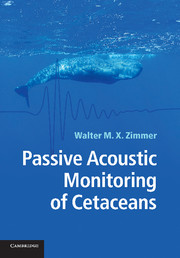Book contents
- Frontmatter
- Contents
- Acknowledgements
- Introduction
- Part I Underwater acoustics (the basics)
- 1 Principles of underwater sound
- 2 Cetacean sounds
- 3 Sonar equations
- Part II Signal processing (designing the tools)
- Part III Passive acoustic monitoring (putting it all together)
- References and further reading
- Index
3 - Sonar equations
Published online by Cambridge University Press: 26 April 2011
- Frontmatter
- Contents
- Acknowledgements
- Introduction
- Part I Underwater acoustics (the basics)
- 1 Principles of underwater sound
- 2 Cetacean sounds
- 3 Sonar equations
- Part II Signal processing (designing the tools)
- Part III Passive acoustic monitoring (putting it all together)
- References and further reading
- Index
Summary
This chapter presents and discusses all parts that add up to the sonar equation, which is the workhorse of sonar design and performance analysis. Here the focus remains on the passive sonar equation, which is further adapted for detecting cetacean sounds.
Starting with the definition of what constitutes passive acoustic detection, the introduction of the signal-to-noise ratio and the detection threshold, the remainder of this chapter discusses the different components of the sonar equation:
Source level
Off-axis attenuation
Sound propagation
Noise level
Array gain of the receiver
Processing gain of the receiver
Discussing sound propagation will be a major part of this chapter and will cover simplified geometric models, but will also introduce reference models from the acoustic modelling community, especially the Bellhop Gaussian ray-trace model.
As the noise level is another key element of the passive sonar equation, its sources and levels will be discussed in more detail.
Passive sonar equations
The sonar equations describe in simple terms the conditions under which sonar systems succeed in remotely detecting signals. They serve two important practical functions: performance prediction of existing sonar systems, and design support of new sonar implementations. The sonar equations come in different flavours depending on whether they are intended for active or passive sonar usage: the passive sonar equation is the relevant form for PAM.
Information
- Type
- Chapter
- Information
- Passive Acoustic Monitoring of Cetaceans , pp. 96 - 116Publisher: Cambridge University PressPrint publication year: 2011
